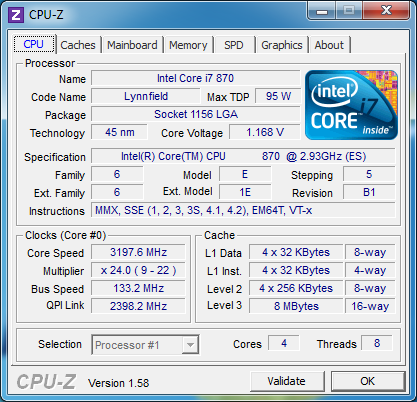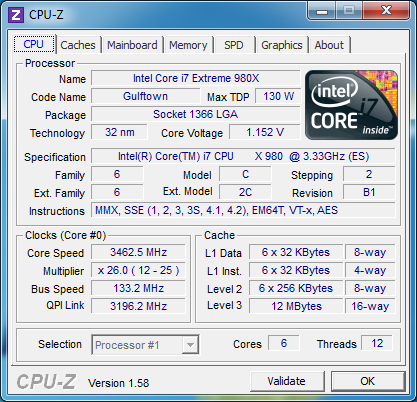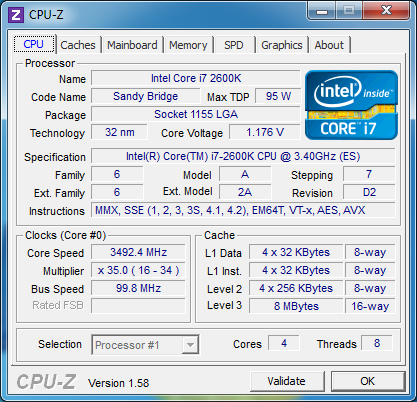AMD FX: Energy Efficiency Compared To Eight Other CPUs
We've already seen AMD's Bulldozer architecture come up short in the performance benchmarks. However, the company also claims it made important improvements to power consumption. Can FX-8150 at least score some points in the energy efficiency department?
Intel CPUs: Core i7-870, Core i7-975 Extreme, Core i7-980X Extreme, And Core i7-2600K
The Core i7 brand is used to label multiple different processor line-ups. Although there are dual-core mobile Core i7s available, on the desktop, a Core i7 is going to be a four- or six-core chip.
The Core i7-870 processor is based on the 45 nm Lynnfield architecture and has four cores, but can execute eight threads in parallel thanks to Hyper-Threading support. The architecture is similar to the Core i5-750, but the base clock is higher, there's more Turbo Boost headroom, and the Core i5s don't come with Hyper-Threading. Also, Lynnfield never got AES-NI functionality. You can find details about this CPU in the article Intel Core i5 And Core i7: Intel’s Mainstream Magnum Opus.
The Core i7-975 Extreme Edition centers on the 45 nm Bloomfield design (the very first Nehalem-based chip to emerge back in 2008). This particular model was launched in 2009, features four cores, 8 MB of shared L3 cache, and a clock rate that scales up to 3.6 GHz in single-threaded apps (and a base 3.3 GHz frequency).
Due to its age, this CPU lacks features like Trusted Execution, VT-d, and AES-NI, however. More details can be found in Intel Core i7-975 Extreme And i7-950 Reviewed
The Core i7-980X Extreme Edition, code-named Gulftown, is the second-fastest processor in Intel's line-up, behind the Core i7-990X. It is manufactured using a 32 nm process, and sports six cores with a total of 12 MB shared L3 cache. Very shortly, the entire Gulftown family will be displaced by the hexa-core Sandy Bridge-E design, sporting an integrated quad-channel DDR3 memory controller and 15 MB of shared L3 cache.
The article Intel Core i7-980X Extreme: Hello, Six-Core Computing presents details of the Gulftown CPU.
Last but not least is Intel's Core i7-2600K. This is another modern processor, based on the Sandy Bridge design. In contrast to Core i5-2500K, its four cores support Hyper-Threading. A base clock of 3.4 GHz accelerates up to 3.8 GHz In single-threaded applications. Our article Intel’s Second-Gen Core CPUs: The Sandy Bridge Review breaks down the details of this CPU's architecture.
Get Tom's Hardware's best news and in-depth reviews, straight to your inbox.
Current page: Intel CPUs: Core i7-870, Core i7-975 Extreme, Core i7-980X Extreme, And Core i7-2600K
Prev Page Intel CPUs: Core i5-750 And Core i5-2500K Next Page AMD’s Challenger: FX-8150
Patrick Schmid was the editor-in-chief for Tom's Hardware from 2005 to 2006. He wrote numerous articles on a wide range of hardware topics, including storage, CPUs, and system builds.
-
compton The low idle and load power consumption numbers of the SB K series are why I love them so much. Less power = less heat and noise, and SB is certainly worth it for me. BD, on the other hand, is just a strange bird. Someone out there could probably find a way to leverage it successfully, and that one person is going to be very happy. Maybe Bulldozer makes a lot more sense in its server configurations -- but I really wish AMD had just given the Phenom II a slight dust-off and die shrink. Everyone was pulling for AMD to do something great with BD, and the efficiency results are just abysmal. If you got great performance, but dis-proportionally high power consumption, that would be okay as well. With BD, you get the worst of both world, and not much of a saving grace. Perhaps Trinity will do something with this albatross that is BD and make it respectable, because the efficiency comparison is embarrasing.Reply -
de5_Roy thank you tom's. this kind of article (performance-efficiency analysis) is one of my favorites. i've been waiting eagerly for an article like this from reviewer sites, tom's beat everyone else. :DReply
the benchmarks with real world softwares(and not some specialized highly threaded synthetic benchmark that gives biased results) are the ones that matter to me. i use some of the softwares occassionally (blender), some more frequently (winrar, 7zip, lame encoder) and this article helped me a lot when i choose my next pc.
did you guys see the ridiculous tdp number on cpu-z screenshot of fx8150? 223 w what the !@#$. i wonder which one got it wrong, amd or cpu-z.
amd-fans-in-denial can argue as much as they want, but the reality didn't change. the efficiency numbers pretty much mirrored the bd review - bd isnt power efficient. even the ph ii 980 - the most power hungry of phenoms is more power efficient than fx 8150. and people who don't care about power consumption should care about the cooling and maintenance bd would need along with a power hungry high performance gfx card. imagine running an air-cooled fx 8150 @ 4.7 ghz with nvidia gtx 580 or radeon hd 6990.
i can use any kind of acronyms like 'lol' or 'lmao' on bd's laughable power efficiency(even lynnfield beat it!) and performance but i am really sad and disappointed.
if amd can't compete with intel, intel will keep selling their cpu at a high(and higher) price - avg users like me will be the loser. -
tacoslave everytime i read a BD article i die a little inside. Plus what we all knew would happen already started Intel already raised the K series prices a couple bucks.Reply -
compton Geez, the 2700K is creeping up on $400. Thanks a lot AMD. You're off my Christmas list.Reply -
dragonsqrrl comptonGeez, the 2700K is creeping up on $400. Thanks a lot AMD. You're off my Christmas list.Ya, the MSRP is $332, but the price on newegg is $370. Even for a brand new processor that's a huge premium over MSRP. It'll stabilize to the $330 price range eventually, but this initial price hike is no doubt related to the Bulldozer launch.Reply -
de5_Roy @compton: phenom might get a die shrink with the llano upgrade. according to the latest trinity leak, llano's new 'husky' core will feature a phenom ii class cpu with amd 6xxx class gpu. this is just a rumor though.Reply -
soccerdocks Thank you very much for including Matlab in the benchmarks. Its a really informative benchmark for those in engineering.Reply -
"Everyone was pulling for AMD to do something great with BD, and the efficiency results are just abysmal."Reply
Not really, for the most time everyone was aware that BD was not going to be a SB killer, AMD themselves had hinted at it, then their PR department (propaganda office I would say) started pumping up the hype.
-
amk-aka-Phantom And this is exactly why AMD fanboys should STFU about Bulldozer being an "excellent server CPU". You don't want high power consumption on a server.Reply -
amk-aka-Phantom dragonsqrrlYa, the MSRP is $332, but the price on newegg is $370. Even for a brand new processor that's a huge premium over MSRP. It'll stabilize to the $330 price range eventually, but this initial price hike is no doubt related to the Bulldozer launch.Reply
2700K is BS... 100MHz extra is definitely not worth it. 2600K and 2500K remain best bang for buck right now.



